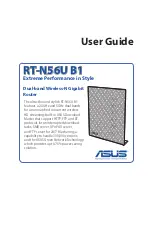
Fragment threshold is the maximum packet size used for fragmentation. Packets larger than the size programmed in
this field will be fragmented.
If you find that your corrupted packets or asymmetric packet reception (all send packets, for example). You may want
to try lowering your fragmentation threshold. This will cause packets to be broken into smaller fragments. These small
fragments, if corrupted, can be resent faster than a larger fragment. Fragmentation increases overhead, so you'll want
to keep this value as close to the maximum value as possible.
What is RTS (Request To Send) Threshold?
The RTS threshold is the packet size at which packet transmission is governed by the RTS/CTS transaction. The
IEEE 802.11-1997 standard allows for short packets to be transmitted without RTS/CTS transactions. Each station
can have a different RTS threshold. RTS/CTS is used when the data packet size exceeds the defined RTS threshold.
With the CSMA/CA transmission mechanism, the transmitting station sends out an RTS packet to the receiving station,
and waits for the receiving station to send back a CTS (Clear to Send) packet before sending the actual packet data.
This setting is useful for networks with many clients. With many clients, and a high network load, there will be many
more collisions. By lowering the RTS threshold, there may be fewer collisions, and performance should improve.
Basically, with a faster RTS threshold, the system can recover from problems faster. RTS packets consume valuable
bandwidth, however, so setting this value too low will limit performance.
What is Beacon Interval?
In addition to data frames that carry information from higher layers, 802.11 includes management and control frames
that support data transfer. The beacon frame, which is a type of management frame, provides the "heartbeat" of a
wireless LAN, enabling stations to establish and maintain communications in an orderly fashion.
Beacon Interval represents the amount of time between beacon transmissions. Before a station enters power save
mode, the station needs the beacon interval to know when to wake up to receive the beacon (and learn whether there
are buffered frames at the access point).
What is Preamble Type?
There are two preamble types defined in IEEE 802.11 specification. A long preamble basically gives the decoder more
time to process the preamble. All 802.11 devices support a long preamble. The short preamble is designed to improve
efficiency (for example, for VoIP systems). The difference between the two is in the Synchronization field. The long
preamble is 128 bits, and the short is 56 bits.
What is SSID Broadcast?
Broadcast of SSID is done in access points by the beacon. This announces your access point (including various bits
of information about it) to the wireless world around it. By disabling that feature, the SSID configured in the client must
match the SSID of the access point.
Some wireless devices don't work properly if SSID isn't broadcast (for example the D-link DWL-120 USB 802.11b
adapter). Generally if your client hardware supports operation with SSID disabled, it's not a bad idea to run that way to
enhance network security. However it's no replacement for WEP, MAC filtering or other protections.
What is Wi-Fi Protected Access (WPA)?
Wi-Fi’s original security mechanism, Wired Equivalent Privacy (WEP), has been viewed as insufficient for securing
confidential business communications. A longer-term solution, the IEEE 802.11i standard, is under development.
However, since the IEEE 802.11i standard is not expected to be published until the end of 2003, several members of
the WI-Fi Alliance teamed up with members of the IEEE 802.11i task group to develop a significant near-term
enhancement to Wi-Fi security. Together, this team developed Wi-Fi Protected Access.
To upgrade a WLAN network to support WPA, Access Points will require a WPA software upgrade. Clients will require
a software upgrade for the network interface card, and possibly a software update for the operating system. For
enterprise networks, an authentication server, typically one that supports RADIUS and the selected EAP
authentication protocol, will be added to the network.
What is WPA2?
It is the second generation of WPA. WPA2 is based on the final IEEE 802.11i amendment to the 802.11 standard.









































